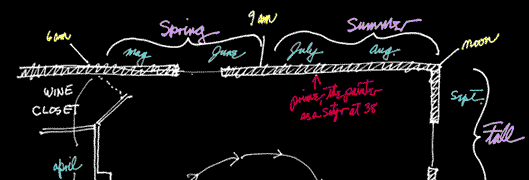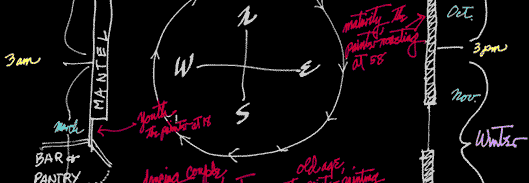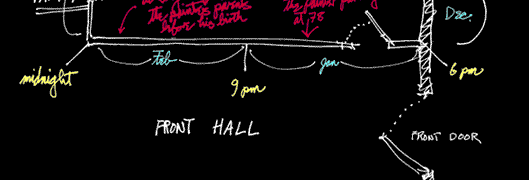






than as murals on four walls. It is the largest painting I have ever made, and I made it inside something, the 17-foot square formal dining room of our home in Newbury, Vermont.
It was executed during the last six months of 1995 in oil paint on Belgian linen canvas affixed to the plaster walls of the room, which had just been restored by a local builder. The windows, doorways, and fireplace are absorbed into the illusory space of the painting and become framing structural elements in its composition. They form ledges and alcoves which are seats of pictorial incident. The actual recessional directions of the chair rail moldings and ceiling edges are continued into the perspective orthogonals of the invented space when viewed from anyplace on a center axis perpendicular to a given wall.
Like all of my painting, this has no single subject or theme but many overlapping ones, most of which were found in the making of the painting since I don't do preparatory drawings or have fixed preconceptions. I have found, however, that if I ponder out loud a few of what to me are immediately apparent schematic motifs, interested viewers may be coaxed into my work of visual fiction and discover other threads, some of which might surprise even me. I hope therefore that this partial catalog of imagery will be taken more as an invitation to speculation about my room rather than as explanations of it or conclusions about it.
The two walls around the windows to the exterior of the house form a continuous landscape as it unfolds in the seasonal cycle of Spring, Summer, Fall, and Winter. The other two walls around the doors to the house's interior, the mantel and faux fireplace, locate themselves in rooms, niches, corridors, and interior spaces.
While the four seasons are played through upon only the two landscape walls, the room as a whole can be read as a twelve month calendar. That is, the South (interior) wall might connote January and February; the west one (also interior) March and April; allowing the two landscape sections to contain allusions to all four seasons in just the remaining eight months of the year: May, June, July, and August on the North wall, and September, October, November, and December on the East one.
If the 360 degrees of the room are an asymmetric calendar they are also a symmetrical analog clock. The Southwest corner of the room fixes midnight and its opposite one, noon, making early spring begin at six a.m.in the Northwest corner and a Winter day terminate in the darkness of six p.m. on the opposite Southeast corner.
We visual artists, because of the arrested object nature of our medium, have never had the ability to command the timing and sequence in which our works are apprehended. This is a control that is assumed as a given by poets, choreographers, novelists, composers, and film-makers. Yet most sculptors and painters -- especially painters -- have always attempted a rhythmic ordering, a setting of forces into motion while still respecting the essential, even sacred, arrestedness of the quiet objects we make.
One way this is done is by the marshalling of visual shapes relative to each other that the scanning eye is stimulated to sense in a sequential pattern or metric beat of the total composition. It is a good part of the magic of the paintings of Piero, Titian, Rembrandt, Vermeer, and Cézanne that their great canvases are enthroned in the integrity of an unshakable stillness, yet they are filled with forms which dance, dart, thrust, flicker, fall and fly.
My allusions in Redwing to hours of the day and times of the year explore another way we painters have had of dealing with time in a timeless world. There is yet a further layer of this kind of chronicled sequence in the room, put into play by my conceit that the dancing anamorphic couple in the Southwest corner is an image of my parents before my birth, followed by four figures of myself (not precisely self portraits but self-evocations) at two-decade intervals around the room: the first is lighting a candle at age eighteen next to the mantel on the West wall, then as a thirty-eight year old satyr brandishing a cello and its bow on the North, followed by the fifty-eight-year- old grilling an autumnal carnal feast, and finally, still painting at seventy-eight in the Pompeiian-red studio on the South wall. Read this way, the room could become in turn the hours of a day, the months of a year, and the intervals of a life.
It has occurred to me since the painting was finished that it is the only one I have ever made which can never be seen all at once; viewers will always have a portion of it behind their heads. Hence not only does it allude to an unfolding in several time scannings, it must in fact be seen in separate parcels of actual time.
The whole composition is punctuated by still life incident. There are the seasonal ones on the faux chair rail molding which anchors the landscape walls; asparagus, of course, under the spring episode; a red/green color reverse watermelon and a tendril-twisted blossoming zucchini complex underlining Summer elides into an apple-potato dialogue in September. Then into Fall and Winter are found oysters, shucked and unshucked, interrupted by a pile of bread loaves (don't fail to note the mouse nibbling through the crust of one) over the November window before December's fur-garbed woman raises a mirror whose interior is formed by an elliptical patch of the room's original wallpaper, which, with its Spring motif of birds and blossoms, is reflecting that season from its position diagonally across the room.
The three still lives over the doors of the interior walls, viewed chronologically from January, are respectively of terracotta-potted grasses, plants and herbs, with a few blooms of lavender and jasmine --kisses blown to my wife, who has a fondness for those flowers; of monkeys maybe browsing but more probably simply pummeling a little cache of books (the simian on the right will be recognized as a variation on an image from Veronese, one of the greatest of all room painters); and of wine bottles and lemons over and falling around the door to the wine storage closet.
The most elaborate still life of all is the one over the fireplace which, in contrast to the quot;natural quot; seasonal clusters fronting the landscape, consists of food and drink which has been confected out of any seasonal appropriateness, though it is positioned at that time somewhere between late winter and early spring that is called "mud season" in New England. This seemed the correct point from which to contemplate boiled lobsters, baked muffins, cuts of yet ungrilled meats, a banana split, and a pitcher of martinis among other gastronomic concoctions. Of course, the presence of the human skull in this complex marks it, and perhaps the whole room, as a vanitas.
But I'm afraid this by no means exhaustive catalogue of just the still life images of my Redwing suggests a further difficulty in taking any iconographic list as an explanation of a painting. Naming is the least of the satisfactions to be derived from visual evocation and the most easily achieved. An accounting of its nominal subject matter can only be a first step in reading what a painting is really about.
My hope is that if Redwing soars it will not be by depicting an accumulation of
interesting things or even truthful ideas but by coming alive as fictive invention on and through the pigment-scored skin of the canvas. That's what I hope might spark the eyes of anyone's receptive imagination.



Enter Gallery here
I think of Redwing more as a painted room
James McGarrell
Newbury, Vermont
January 1997